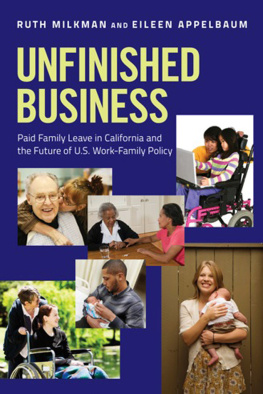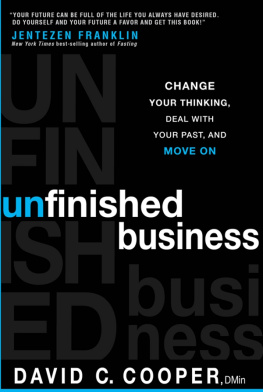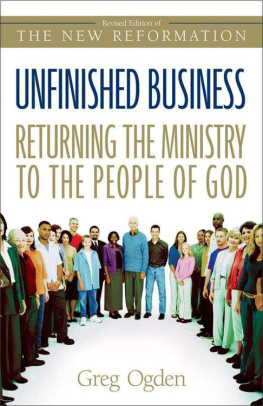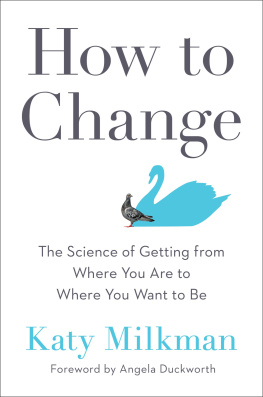ACKNOWLEDGMENTS
We have been at work on this project for more than a decade. It began immediately after the California legislature passed the bill creating the nations first paid family leave (PFL) program in the fall of 2002, when we spotted a window of opportunityafter the legislation was passed but before the program would begin operating, in mid-2004to collect baseline data on how workers and employers were managing the kinds of family events the new PFL program would soon cover. Funding for that crucial initial stage of our research came primarily from the National Institute for Child Health and Development (NICHD). We are deeply grateful to Lynne Casper, then an NICHD program officer, who understood the uniqueness of that historical moment and guided us through the NICHD funding process, making the initial surveys of employers and workers possible on very short notice. At the Alfred P. Sloan Foundation, Kathleen Christensen supplemented the NICHD funding with a program officers grant that supported our first round of fieldwork. The UCLA Institute for Labor and Employment also helped to fund this early stage of our work. We are also grateful to the Schumann Fund for New Jersey, and its program officer Barbara Riesman, for funding our fieldwork in that stateshortly before it became the second state to create a paid leave program, providing a valuable comparative perspective on the California case.
In 2009, we received a second round of funding for the follow-up phase of our data collection, making it possible to conduct surveys examining the impact of the PFL program on employers and workers. We thank the Ford Foundation, the Annie E. Casey Foundation, the Russell Sage Foundation, and the Rockefeller Family Fund for making this work possible. We are grateful to Anna Wadia and Helen Neuborne at Ford, Beadsie Woo at AECF, and Aixa Cintron and Eric Wanner at RSF for their generous and ongoing support for this effort. Supplementary funding also came from the California Employment Development Department, where Sandra Poole and Janet Botill provided vital support. Finally, we thank Lisa Guide at the Rockefeller Family Fund, which provided us with a dissemination grant, and the UCLA Institute for Research on Labor and Employment, which provided a planning grant for the second phase of the project.
We were fortunate to work with three different survey research centers whose skilled professional staff assisted us at many stages of the project. We thank Yuteh Cheng, Bob Lee, and Jeff Royal at the UC Berkeley Survey Research Center (which unfortunately no longer exists); Ken Gross at California Survey Research Services; and Mary Ellen Colten, Carol Cosenza, Anthony Roman, and Kirk Larsen at the Center for Survey Research at the University of Massachusetts, Boston.
Many talented graduate students helped us carry out this highly labor-intensive project over the past decade. At UCLA we were fortunate to work with Andrea Dinneen, Patricia Donze, Ana Luz Gonzalez, Marisa Gerstein Pineau, Daisy Rooks, Claudia Solari, and Anita Yuan; Rhokeun Park at Rutgers University; and finally, at the CUNY Graduate Center, David Frank, Erin Michaels, and especially Laura Braslow provided invaluable assistance. In addition, Karen White and Kristen Pipes at the Rutgers University Center for Women and Work provided excellent support for our fieldwork. Yadira Santoyo and other staff at the UCLA Institute for Research on Labor and Employment provided ongoing administrative support for this work. And at the Center for Economic and Policy Research John Schmitt helped us on several occasions with insightful advice about and analysis of various U.S. government data sets, and research assistant Janelle Jones, program coordinator Kris Warner, and intern Alexandra Mitukiewicz also provided helpful assistance to our project. CEPRs Milla Sanes was extraordinarily helpful in designing the final graphs for the book.
We also benefited greatly from the expert advice of other researchers in this field. Donna Benton, Heather Boushey, Janet Currie, Paul Chung, Janet Gornick, Diane Halpern, Frank Neuhauser, Ann OLeary, Judith Seltzer, Mark Schuster, and Jane Waldfogel were generous and wise in advising us on the research design. Equally crucial was the expertise of Jennifer Richard, a legislative aide to then California state senator Sheila Kuehl, who carried the bill that created paid family leave. We also learned a great deal from Tom Rankin, then president of the California Labor Federation, who helped get the PFL program legislation passed, and Rona Sheriff, then of the State Senate Office of Research, who played a key role in its implementation. Thanks also to Sharon Terman of the Legal Aid SocietyEmployment Law Center in San Francisco for her work on the content and design of .
Ellen Bravo, a tireless advocate for working women generally and family leave in particular, first at 9 to 5 and now at the Family Values @Work Consortium, also advised us at many crucial points. Our greatest debt is to Netsy Firestein, who directs the Labor Project for Working Families, and her entire staff. Netsy not only played a leading role in the advocacy and organizing that led to the establishment of paid family leave in California but also advised and supported us at every stage of the research that led to this book. Our heartfelt thanks to her as well as to Janet Gornick and an anonymous reviewer for Cornell University Press, all three of whom carefully read a full draft of this book and provided us with invaluable feedback.
Portions of this book previously appeared in Paid Family Leave in California: New Research Findings, by Ruth Milkman and Eileen Appelbaum, in The State of California Labor 2004 (University of California Press, 2004), 4570, and in Class Disparities, Market Fundamentalism and Work-Family Policy: Lessons from California, by Ruth Milkman, in Gender Equality: Transforming Family Divisions of Labor , ed. Janet C. Gornick and Marcia K. Meyers (Verso, 2009), 33964, though much of the material has been revised.
1
INTRODUCTION
The Case for Paid Family Leave
California made history on September 23, 2002, when Governor Gray Davis signed a bill into law creating the nations first comprehensive paid family leave (PFL) program. Although nearly every other country in the world guarantees paid leave to employed mothers (and in many cases, fathers as well) when they take time off to care for a new child, the United States is famously exceptional in its failure to do so.
The Need for Family Leave
As family and work patterns have shifted in the United States, demand for time off from paid work to attend to family needs has increased dramatically. Several recent social trends have contributed to this growth. The most important among them are rising female labor force participation, especially among mothers; the aging of the population and the accompanying surge in demand for eldercare; and mens increased involvement (although it remains relatively modest) in parenting and other types of unpaid caregiving.
In the past, most family care was provided on an unpaid basis by wives and mothers, who typically withdrew from the labor force entirely when their children were young or when other family members needed assistance. But over the past century, female labor force participation rates, especially among mothers of young children, have increased dramatically; by 2010, women were 47 percent of the civilian labor force. Between 1975 and 2010 alone, the participation rate for mothers with children under age three almost doubled, rising from 34 percent to 61 percent. In a sharp historical reversal, mothers are now more likely to be in the labor force than women generally: the overall female labor force participation rate in 2010 was 59 percent (U.S. Department of Labor 2011a, 45, 19). Employment during pregnancy has also become the norm: in the first decade of the twenty-first century, about two-thirds of first-time mothers in the United States were employed while pregnant, up from 44 percent in the early 1960s (Laughlin 2011, 4). Although many women still leave the labor force for brief periods when they have children, they are far more likely than in the past to be continuously employed over the course of the life cycle. Most mothers in the twenty-first century, then, must find ways to balance the needs of their children with the demands of their jobs.











